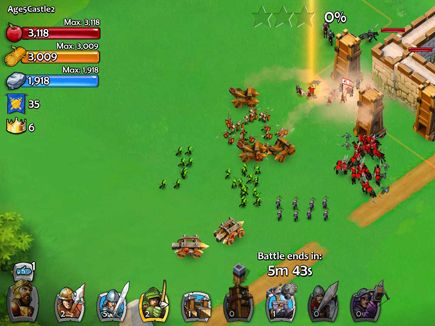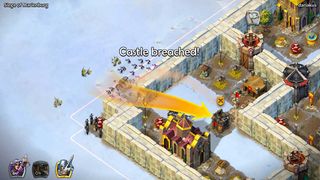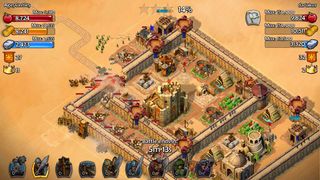Age of Empires: Castle Siege Review — Fallen Empire
In Age of Empires: Castle Siege, the most compelling choice you'll make is whether to waste your money or your time.
Why you can trust Tom's Guide

Since its debut in 1997, the Age of Empires series has excelled in offering players compelling choices. As you took command of history's greatest civilizations, you could choose to control the praetorian might of Rome, the structural grandeur of Byzantium or the relentless tenacity of the Sioux.
You could raze your enemies' strongholds to the ground, corner the global economy or build a wonder to last through the ages. You could amass a horde of cavalry archers to sweep across the Mongolian steppes, train a battalion of war elephants to trample your foes or launch an unstoppable navy to lay low the great cities of the Holy Land.
In the newly released Age of Empires: Castle Siege, the most compelling choice you'll make is whether you want to waste your money or your time.
In theory, Castle Siege is developer Smoking Gun Interactive's attempt to bring the inimitable Age of Empires franchise to a Clash of Clans-style mobile game. The result is enough to make any longtime series fan weep. Not only is the game little more than a delivery vessel for microtransactions, but it also manages to eschew almost everything that has delighted series fans for the last 17 years.

Gameplay
Castle Siege isn't something you play so much as it's something you throw money at over and over, hoping against hope for a brief, shining moment of gameplay. Perhaps there is a real game lurking somewhere beneath Castle Siege's admittedly attractive exterior, but if so, the only amusement to be had is on Microsoft's end. The company publishes the game and owns the rights to the series, and it looks as if it is seeing how much money it can milk out of trusting fans who deserved better.
MORE: 15 Fun Facebook Games
To be fair, the game looks a lot like a traditional Age of Empires experience, at first blush. You start with a limited number of resources (food and wood) and construct mills and farms in order to gather more. When you get enough resources, you can build military structures and recruit an army to wage war on enemy towns. Earn enough resources, and you can bring your civilization into the next Age, which gives you access to new buildings, new technology and new types of soldiers.
So far, so good, but remember, this is not a traditional real-time strategy game: This is a free-to-play title. That means that everything you do takes time — and not the few seconds to a minute that buildings and units usually required in previous installments. As you get past the tutorial phase ofCastle Siege, training units takes three to five minutes. Upgrading a building might take half an hour. Constructing a whole new building can take up to a day — and of course, you can only construct or upgrade four buildings at a time.

If you're wondering why the game places such draconian restrictions on the fun bits, the answer is simple: to make money. You need to pay to get ahead more quickly.
Complaining about microtransactions in a free-to-play game is always tricky, since making games is costly and the developers have to recoup their expenses somehow. Still, there are good and bad ways to ask players for money, and Castle Siege has some of the most manipulative schemes I've ever encountered.
In addition to food, wood and (later on) stone, there's one more resource to collect: gold. While you can earn a paltry amount by making war with other players or constructing roads, the best way to get gold is to fork over your real-world valuables to Microsoft.
Gold is the game's all-purpose "speed-up" currency, and gold microtransactions are attached to literally everything in the game. Want to finish building that cathedral before Islamic warriors sweep across the Middle East? Fork over some cash. Need some food and wood to meet the game's exorbitant resource requirements for structural upgrades? That'll cost you some gold. Require an army sometime before the soldiers are ready for veterans’ benefits? Pay up.
To give you an idea of how quickly the game encourages you to cough up dough, I had about $10 of gold provided by Microsoft to help me review the game. While building up my city in the game's middle stages, I spent every last coin within 15 minutes. It was either that or wait approximately two days for everything to finish.

Military Unintelligence
Remember that bit about needing soldiers? Well, you're going to need them, and you're going to need them more often than ever before. Castle Siege resets your army to zero after every single battle — even if your Napoleonic tactical brilliance spared the life of every swordsman, archer and siege engineer under your command. One must assume that in the world of Castle Siege, soldiers are highly excitable and, like Sherlock Holmes without a mystery to solve or enough cocaine to subdue a bull hippopotamus, spontaneously combust outside of combat.
This makes building an army a joyless, monotonous task rather than a strategic pleasure. After all, what's the point of building a well-balanced attack force and directing each unit with meticulous precision when a victory-by-numbers suicide charge works just as well with just as much (or more accurately, just as little) reward?
Even when you get into battles, there's not much fun to be had. Units move and attack automatically, and never work with any kind of cooperative instincts. Unless you micromanage every single squad, expect your axemen to engage in a suicidal charge against a castle while your swordsmen destroy a particularly menacing farm and your crossbowmen cheerfully stand around getting mowed down by cavalry.

There are two ways to fight: skirmishes against other players and campaign missions, of which there are a whopping 10. Fighting other players is a way to earn resources, but it's not a particularly good way. As previously stated, soldiers are good for one use only, and when you raid other players, you'll just about break even — at best. To add insult to injury, even finding other players to fight costs resources, and the expense increases as your city grows.
Rather than real-time battles, multiplayer in Castle Siege is asynchronous. Players set up their cities, complete with archer towers, soldier patrols and caltrops, and see if their structures can withstand an enemy siege. Spoiler: They usually can't. Until you reach very high levels, your defensive options are limited, and other players can take your resources and crowns (which measure how well you do in multiplayer) with relative impunity.
The campaign is also a far cry from the sweeping historical epics of previous games. You'll reenact real battles at historical locations such as Aleppo, Thessalonica and Kiev, but you'll only get one battle per civilization. This makes the campaign feel disconnected and not particularly educational.
Worse still, you don't get to design your own armies for the campaign, so if the game sends you to besiege Constantinople without any siege weapons (and it does), you'd better figure out exactly how to maneuver a small group of soldiers into the heart of the enemy castle. Given your limited, nonselectable troops, the campaign is more like a puzzle game than a strategy title, and proves more frustrating than fun.

Graphics and Art
The one shining ray of hope that pierces Castle Siege's otherwise impermeable darkness is the way it looks. Castle Siege embraces a bright, colorful, cartoony art style, and every civilization looks distinct. From the sandy deserts of the Saracens to the snow-covered plains of the Kievan Rus, there's something gorgeous to behold from every corner of the ancient world.
Likewise, the animations are about as smooth as they come, and each collection of units behaves differently. Watching a group of raiders charge toward a wall and scale it on tiny yellow ladders is as interesting as watching a group of swordsmen methodically approach a group of enemy soldiers, or a catapult lay low a whole battalion of archers. If only players could control the action with more precision.

Music and Sound
The Age of Empires series used to be synonymous with memorable soundtracks, but that's no longer the case. The music in Castle Siege is passable, but I'd be hard-pressed to hum a single tune from it — when the sound worked at all. It would frequently cut out, especially when I was managing my home city. Often, I didn't even realize it was gone.
MORE: 15 Best Windows 8 Games
The sound effects also fade into the background, and there's no voice acting to speak of. If you turn the sound off entirely, you're not missing anything.

Bottom Line
Age of Empires: Castle Siege managed to do what no previous entry in the series, however questionable, could: It broke my heart. It made me question whether Microsoft can save this series, and whether it's even worth saving.
You could spend dozens, even hundreds, of dollars and get nowhere, or you could tend to your city assiduously for weeks and weeks and end up at the same nowhere. Either way, you are spending a valuable resource in exchange for not having fun — or perhaps the slightest bit of fun, surrounded by hours upon hours of meaningless grind. It's not a good transaction.
Since the game is free, you may as well download it if it strikes your fancy, but don't expect much in the way of positive emotions. If there's one thing Age of Empires has taught us, it's that all empires eventually fall and fade into the mists of history.
This is the end of a gaming empire that spanned history from Ancient Egypt to the Sioux Wars. It met its fate, as so many historical civilizations do, due to an unquenchable lust for gold.
Specs
Publisher: Microsoft Studios
Developer: Smoking Gun Interactive
Genre: Strategy
Price: Free-to-play with microtransactions
Release Date: 9/17/14
Platforms: Windows 8, Windows Phone 8
| Our Favorite Gaming Hardware: |
| Best Gaming Mice |
| Best Gaming Desktops |
| Best Gaming Keyboards |
Marshall Honorof is a Staff Writer for Tom's Guide. Contact him at mhonorof@tomsguide.com. Follow him @marshallhonorof and on Google+. Follow us @tomsguide, on Facebook and on Google+.
Sign up to get the BEST of Tom's Guide direct to your inbox.
Get instant access to breaking news, the hottest reviews, great deals and helpful tips.
Marshall Honorof is a senior editor for Tom's Guide, overseeing the site's coverage of gaming hardware and software. He comes from a science writing background, having studied paleomammalogy, biological anthropology, and the history of science and technology. After hours, you can find him practicing taekwondo or doing deep dives on classic sci-fi.
